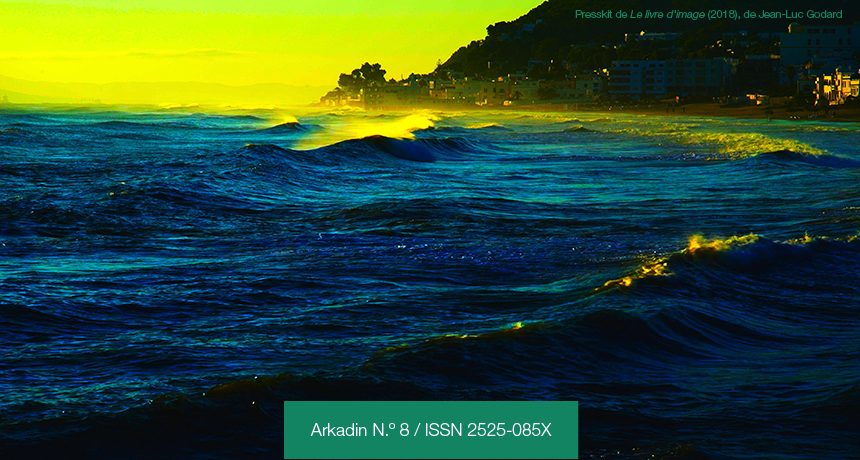About the Movie Istmo. Cinema-essay and Postmemory
DOI:
https://doi.org/10.24215/2525085Xe010Keywords:
Cinema, essay, postmemory, documentary, portraitAbstract
This article reflects on historical and theoretical research and technical-esthetics audiovisual topics formulated in the feature film Istmo (2016). It was made as a postgraduate theses on Audiovisual Communication degree in the Faculty of arts of National University of La Plata. The film tells a story about father and daughter and also inquires about the story of their town Federación (Entre Ríos, Argentina) and its effects. Istmo takes note of different visual and sound resources that are blended together through montage as a way to shows a postmemory construction lead by the director where she examines traumatic experiences and facts including her father personal stories.References
Català Domènech, J. M. (2005). Film-ensayo y vanguardia. En J. Cerdán y C. Torreiro (Eds.), Documental y vanguardia (pp. 109-158). Madrid, España: Cátedra.
Català Domènech, J. M. (2015). Documental expandido. Estética del pensamiento complejo. En P. Mora y otros. (Eds.), Fronteras Expandidas. El documental en Iberoamérica (pp. 17-39). Recuperado de https://www.academia.edu/36458827/Documental_expandido._Est%C3%A9tica_del_pensamiento_complejo
Catullo, M. R. y Coun, E. (2002). Estudios de impactos sociales en el Mercosur. Procesos relocalizatorios, nuevos espacios urbanos y reconstrucción de redes de relaciones sociales. Cuadernos de Antropología Social, (15), 49-69. Recuperado de http://revistascientificas.filo.uba.ar/index.php/CAS/article/view/4617
Cuevas Álvarez, E. (2005). Diálogos entre el documental y la vanguardia en clave autobiográfica. En J. Cerdán y C. Torreiro (Eds.). Documental y vanguardia (pp. 219-250). Madrid, España: Cátedra.
Galeano, E. (1989). El libro de los abrazos. Madrid, España: Siglo Veintiuno.
Halbwachs, M. (1990). Espacio y memoria colectiva. Estudios sobre las culturas contemporáneas, 3(9), 11-40 Recuperado de https://www.culturascontemporaneas.com/culturascontemporaneas/contenidos/espacio_y_memoria_colectiva.pdf
Hernándes Navarro, M. Á. (2010). Hacer visible el pasado: el artista como
historiador (benjamimiano). Recuperado de https://sede.educacion.gob.es/publiventa/detalle.action?cod=14194C
Hirsch, M. (1997). Family Frames: Photography, Narrative, and Postmemory. Cambridge, Reino Unido: Harvard University Press.
Jacobsen, U. y Lorenzo S. (2009). Apuntes y notas (provisorias) sobre el ensayo fílmico (en Chile). Valparaiso, Chile: Autoedición.
Lopate, D. (2007). A la búsqueda del centauro: el cine-ensayo. En AA. VV. La forma que piensa. Tentativas en torno al cine-ensayo (pp. 66-89), Pamplona, España: Fondo de publicaciones del gobierno de Navarra.
Montero-Sánchez, D. (2006). La Herencia De Montaigne. Trayectos posibles para una caracterización del ensayo cinematográfico. Ponencia presentada en II International Congress On European Contemporary Cinema, Universidad Pompeu Fabra, Barcelona, España. Recuperado de http://www.ocec.eu/pdf/2006/montero_david.pdf
Nichols, B. (2001). Introduction to documentary. Bloomington, Estados Unidos: Indiana University Press.
Pinilla, R. y Rabe, A. M. (2010). Los espacios de la memoria en la obra de Walter Benjamin. Constelaciones- Revista de Teoría Crítica, (2), 289-300. Recuperado de http://constelaciones-rtc.net/article/view/729/782
Quílez Esteve, L. (2013). De aquí a allá, de ayer a hoy: Posmemoria y cine documental en la España y Argentina contemporáneas. Olivar, 14(20), 47-75. Recuperado de http://www.memoria.fahce.unlp.edu.ar/art_revistas/pr.6612/pr.6612.pdf
Quílez Esteve, L. (2014). Memorias protésicas: Posmemoria y cine documental en la España contemporánea. Historia Y Comunicación Social, 18, 387-398. Recuperado de https://revistas.ucm.es/index.php/HICS/article/view/43974
Quílez Esteve, L. y Rueda Laffond, J. C. (2017). Posmemoria de la guerra civil y el franquismo. Narrativas audiovisuales y producciones culturales del siglo XXI. Granada, España: Comares.
Quintana, A. (2007). Al principio fue el verbo. Notas sobre el ciné-essai. En AA. VV. La forma que piensa. Tentativas en torno al cine-ensayo (pp.126-139). Pamplona, España: Fondo de publicaciones del gobierno de Navarra.
Downloads
Published
How to Cite
Issue
Section
License
The acceptance of the manuscript by the magazine means the non-exclusive cession of the property rights of the authors in favour of the editor, who allows the reuse, after publication (post print), under a license Attribution-NonCommercial-NoDerivatives 4.0 International.
According to these terms, the material can be copied and redistributed by any means or in any format as long as a) the author and original source of the publication are quoted (magazine and URL of the work), access to the license is provided and whether changes have been made is mentioned; and b) the material is not used for commercial purposes.
The cession of non-exclusive rights means that after the publication (post print) in Arkadin the authors can publish their work in any language, means and format; in such cases it must be mentioned that the material was originally published in this magazine. Such cession also means the authorization of the authors for the work to be collected by SEDICI, the institutional archive of the Universidad Nacional de La Plata, and to be spread in the databases that the editorial team considers appropriate to increase the visibility of the publication and its authors.
Moreover, the magazine encourages the authors to deposit their productions in other institutional and thematic archives under the principle that offering the society the scientific and academic production without any restrictions contributes to a greater exchange of the global knowledge.
























